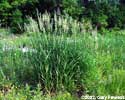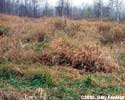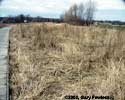
Invasive Plants of Wisconsin
|
Reed Canary Grass (Phalaris arundinacea L.) is perhaps the worst invasive species in Wisconsin, to date. It forms dense, nearly pure stands that displace all other species from large areas of wetlands, especially sedge meadows. Colonizing plants soon spread by rhizomes to form ever larger clones. When in flower, the branches of the inflorescences tend to spread out and may be any shade of color between medium purple and bright green. After pollination occurs (early June) the branches close back on the central axis to assume the appearance of a spike and the flowers eventually turn to a light tan color and may remain on the stems well into the fall and winter. Leaves often exceed 1 cm in width, broader than virtually all other grasses in our wetlands, except for common reed grass (Phragmites australis). Control of Phalaris is extremely difficult and there are few if any examples of longterm success in heavily infested sites in disturbed landscapes. Although the plants can be killed by a variety of methods, vigorous re-invasion is common and none of our native species appear to be capable of competing with Phalaris in a disturbed landscape. Wetlands receiving a large share of water from ground water are more resistant to invasion. Recommendations for control of Phalaris are similar to those for Phragmites australis. As in all invasive plant control problems, the best return for limited resources rests in prioritization of sites, regular monitoring for early discovery and removal, and vigilance thereafter. Because Phalaris does not usually produce large numbers of new seedlings, one of the most effective means for control is to monitor susceptible areas and destroy any new plants before they can expand vegetatively. This is especially true in cases where wetlands have been disturbed, or in recently created or restored wetlands. When an established wetland vegetation of native plants is in place, the incidence of colonization by Phalaris is much reduced and expansion of the clones is much slower. Application of herbicides can be effective in killing established populations of Phalaris, but may also kill other, more desirable plants in the area and if the site is not monitored thereafter, any surviving plants can quickly reoccupy the area. Expectations are low for restoring large, long-established populations in disturbed landscapes.
|
|








